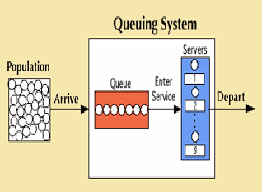A Single Server Queuing System Operations Research 1. A single-server queuing system with an infinite calling population and a first-come, first-served queue discipline has the following arrival and service rates:
λ = 22 customers per hour
µ = 25 customers per hour
Determine P0, P4, L, Lq, W, Wq, and U.

2. An immigration agent at an airport, on an average, could process 15 entrants in one hour, if he was busy all the time. On an average, an entrant arrives at his station at every 5 minutes. The current agent can be replaced by a more efficient specialist. The specialist can process 18 entrants in one hour. The specialist is paid $30 per hour whereas the current agent is paid $25 per hour. An entrant’s time is considered to be worth $10 per hour. Calculate the total cost of paying the current agent and the entrants’ time in the system and the total cost of paying the specialist and the entrants’ time in the system to decide whether to replace the current agent with the specialist.
A Single Server Queuing System Operations Research Hand Calculation
Note: Do hand calculations to answer this question. Show all details of your answer.
3. A grocery store has four check-out counters. The average service rate for each check-out counter is 20 customers per hour. The average arrival rate is 68 customers per hour. Assuming it is a multiple-server waiting line model; determine the average number of customers waiting for a check-out counter and the average time a customer must wait for a check-out counter. What is the probability that there will be 5 customers in the system?
Note: Use QM for Windows to answer this question. Include the results from QM for Windows with your submission. If you do not have access to QM for Windows, then you can use the formulas given in The Multiple-Server Waiting Line section of Chapter 13 in the textbook.
A Single Server Queuing System Operations Research Notes
– Each student must solve Homework 6 problems individually by himself/herself or within the team he/she is a member of. Please do not ask for help from anyone else to answer any questions in this homework.
– Please include all details and steps performed to find your answers. Just writing the final answers will not get you full credit.
– Please post your answers in your assignments folder on the course website.
– A team can post their answers in the assignments folder of any one of the team members but the submission must contain names of all team members. A member whose name is missing from the assignment will not receive any credit.
A Single Server Queuing System Operations Research Submission and Grading
– A team submission will be graded based on the answers submitted by the team. If answer to one or more questions is missing because a member of the team did not do his/her part, then the team will not receive any credit for those questions.
Homework 6: OPRE 315
Please answer the following questions giving all details.
1. A single-server queuing system with an infinite calling population and a first-come, first-served queue discipline has the following arrival and service rates:
λ = 22 customers per hour
µ = 25 customers per hour
Determine P0, P4, L, Lq, W, Wq, and U.
2. An immigration agent at an airport, on an average, could process 15 entrants in one hour, if he was busy all the time. On an average, an entrant arrives at his station at every 5 minutes. The current agent can be replaced by a more efficient specialist. The specialist can process 18 entrants in one hour. The specialist is paid $30 per hour whereas the current agent is paid $25 per hour. An entrant’s time is considered to be worth $10 per hour. Calculate the total cost of paying the current agent and the entrants’ time in the system and the total cost of paying the specialist and the entrants’ time in the system to decide whether to replace the current agent with the specialist.
Note: Do hand calculations to answer this question. Show all details of your answer.
3. A grocery store has four check-out counters. The average service rate for each check-out counter is 20 customers per hour. The average arrival rate is 68 customers per hour. Assuming it is a multiple-server waiting line model; determine the average number of customers waiting for a check-out counter and the average time a customer must wait for a check-out counter. What is the probability that there will be 5 customers in the system?
Note: Use QM for Windows to answer this question. Include the results from QM for Windows with your submission. If you do not have access to QM for Windows, then you can use the formulas given in The Multiple-Server Waiting Line section of Chapter 13 in the textbook.
Notes:
– Each student must solve Homework 6 problems individually by himself/herself or within the team he/she is a member of. Please do not ask for help from anyone else to answer any questions in this homework.
– Please include all details and steps performed to find your answers. Just writing the final answers will not get you full credit.
– Please post your answers in your assignments folder on the course website.
– A team can post their answers in the assignments folder of any one of the team members but the submission must contain names of all team members. A member whose name is missing from the assignment will not receive any credit.
– A team submission will be graded based on the answers submitted by the team. If answer to one or more questions is missing because a member of the team did not do his/her part, then the team will not receive any credit for those questions.




